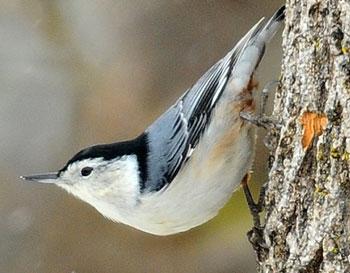Birds Triumph Over the Cold

White-breasted Nuthatch
Photo credit: Jim Williams
by Val Cunningham
Contributing Writer
A backyard scene: winds howl, clouds scud, snow accumulates but even in this maelstrom, dark little juncos hop under feeders, flashy red cardinals scratch under a pine tree, a natty nuthatch spirals down a tree trunk and big blue jays muscle in for a meal.
“Brrrrr,” we shudder, “how can they stand this cold?” But if we think about it for a minute, we realize that our one always-reliable defense against winter’s blasts is that down coat hanging in the closet. Down coats are filled with feathers, the best insulator in the world, and all birds are covered by feathers.
Their plumage, layer upon layer of feathers, keeps out the cold. But that’s only half the survival story: Birds consume calories during all the daylight hours in winter to stoke their inner furnaces, thereby maintaining a constant body temperature. Yes, the primary winter activity of the birds in our backyards is foraging and eating.
The winter landscape may look barren to us, but not to the hardy birds that live and even thrive at our latitude. Their sharp eyes detect shriveled berries on tree and bush, their probing beaks pull out insect eggs and caterpillars hidden in tree bark and on conifer needles, and flower heads offer abundant seeds to finches and sparrows.
Stop in again
Some 15 species of winter-resident birds—-cardinals, chickadees, several kinds of woodpeckers, nuthatches, house finches and goldfinches, blue jays, crows, juncos, starlings, house sparrows, kinglets and brown creepers—may flit through a landscape, including your backyard, several times a day. Many of these have favorite feeding sites and travel in small flocks on a circuit between them on a daily basis.
Summer’s sweet berries are long gone (the grape, mulberry, dogwood and choke cherry fruit), but harder, even shriveled berries now become popular. Hackberry trees host big flocks of birds, especially the robins that spend the winter. Several kinds of viburnum bushes, especially nannyberry and arrow-wood, hold berries that ripen late in the season and these are eagerly snapped up by birds.
In fact, noted biologist Bernd Heinrich, in his book, Winter World, closely watched the shrubs in the beaver bog behind his cabin. In typical meticulous fashion, he weighed the berries from 20 arrow-wood bushes and extrapolated to the entire bog, finding that the yield was just over a ton of early winter bird food. Amazing as it may seem, these and other trees and shrubs have evolved with birds to offer their bounty exactly when other sources of food are scare in the wild. In this way they ensure that birds eat every last berry and scatter the seeds widely.
Wild cuisine
Naturalists note that our bird feeders provide only about 25 percent of the calories a bird eats each winter day. The rest comes from the wild:
• goldfinches gather in fields to consume ragweed, thistle and goldenrod seeds;
• chickadees busily search for eggs of small insects and spiders in bark and on pine needles;
• cardinals form loose flocks to forage for berries, seeds and fruit;
• nuthatches are the “head down” birds, descending tree trunks searching for insect material in bark crevices (they also cache a lot of food to eat later);
• downy woodpeckers peck at shallow bark and goldenrod galls to snare insect larvae and eggs, and eat fruit, too;
• bigger woodpeckers, like the hairys and red-bellieds, use their large beaks to drill into wood in search of insect larvae;
• juncos are ground feeders, searching for dropped seeds;
• crows roam for corn in harvested fields, weed seeds and berries, and 25 percent of their diet is made up of roadkill and garbage.
But winter’s birds still appreciate well-stocked feeders as a reliable source of energy on a cold winter day. Anything more than a dusting of snow can be a problem for ground feeding birds, since it covers up much of their food. So let’s vow to sweep snow away from spots favored by ground feeding birds, and hang more feeders this winter and keep them stocked with seed and suet. And consider adding a heater to your birdbath, I can’t emphasize this enough—birds need to drink, even on the coldest days. A reliable source of open water will bring in more of the neighborhood’s birds than your feeders do.
St. Paul, Minn., resident Val Cunningham, who leads bird hikes for the St. Paul Audubon Society and writes about nature for local, regional and national newspapers and magazines, can be reached at valwrites@comcast.net



